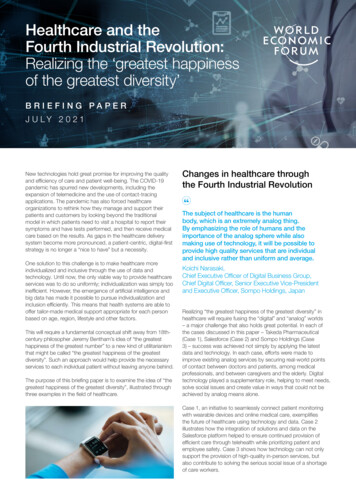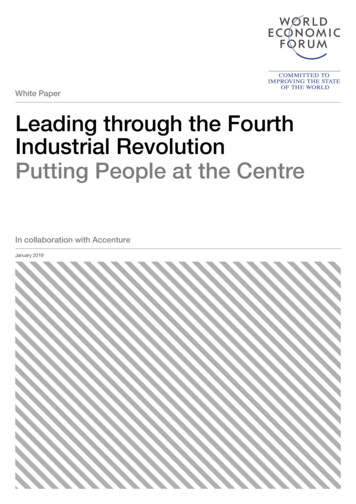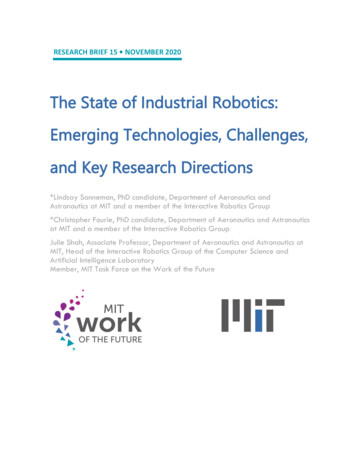
Transcription
Healthcare and theFourth Industrial Revolution:Realizing the ‘greatest happinessof the greatest diversity’BRIEFING PAPERJ U LY 2 0 21New technologies hold great promise for improving the qualityand efficiency of care and patient well-being. The COVID-19pandemic has spurred new developments, including theexpansion of telemedicine and the use of contact-tracingapplications. The pandemic has also forced healthcareorganizations to rethink how they manage and support theirpatients and customers by looking beyond the traditionalmodel in which patients need to visit a hospital to report theirsymptoms and have tests performed, and then receive medicalcare based on the results. As gaps in the healthcare deliverysystem become more pronounced, a patient-centric, digital-firststrategy is no longer a “nice to have” but a necessity.One solution to this challenge is to make healthcare moreindividualized and inclusive through the use of data andtechnology. Until now, the only viable way to provide healthcareservices was to do so uniformly; individualization was simply tooinefficient. However, the emergence of artificial intelligence andbig data has made it possible to pursue individualization andinclusion efficiently. This means that health systems are able tooffer tailor-made medical support appropriate for each personbased on age, region, lifestyle and other factors.This will require a fundamental conceptual shift away from 18thcentury philosopher Jeremy Bentham’s idea of “the greatesthappiness of the greatest number” to a new kind of utilitarianismthat might be called “the greatest happiness of the greatestdiversity”. Such an approach would help provide the necessaryservices to each individual patient without leaving anyone behind.The purpose of this briefing paper is to examine the idea of “thegreatest happiness of the greatest diversity”, illustrated throughthree examples in the field of healthcare.Changes in healthcare throughthe Fourth Industrial RevolutionThe subject of healthcare is the humanbody, which is an extremely analog thing.By emphasizing the role of humans and theimportance of the analog sphere while alsomaking use of technology, it will be possible toprovide high quality services that are individualand inclusive rather than uniform and average.Koichi Narasaki,Chief Executive Officer of Digital Business Group,Chief Digital Officer, Senior Executive Vice-Presidentand Executive Officer, Sompo Holdings, JapanRealizing “the greatest happiness of the greatest diversity” inhealthcare will require fusing the “digital” and “analog” worlds– a major challenge that also holds great potential. In each ofthe cases discussed in this paper – Takeda Pharmaceutical(Case 1), Salesforce (Case 2) and Sompo Holdings (Case3) – success was achieved not simply by applying the latestdata and technology. In each case, efforts were made toimprove existing analog services by securing real-world pointsof contact between doctors and patients, among medicalprofessionals, and between caregivers and the elderly. Digitaltechnology played a supplementary role, helping to meet needs,solve social issues and create value in ways that could not beachieved by analog means alone.Case 1, an initiative to seamlessly connect patient monitoringwith wearable devices and online medical care, exemplifiesthe future of healthcare using technology and data. Case 2illustrates how the integration of solutions and data on theSalesforce platform helped to ensure continued provision ofefficient care through telehealth while prioritizing patient andemployee safety. Case 3 shows how technology can not onlysupport the provision of high-quality in-person services, butalso contribute to solving the serious social issue of a shortageof care workers.
CASE 1Takeda PharmaceuticalCare for One: Pilot project fornext-generation healthcaresystem for Parkinson’s diseaseSummaryIn 2020, Takeda Pharmaceutical and Kanagawa Prefecturein Japan began a pilot study for a next-generation healthcaresystem. Care for One is a platform that seamlessly connectswearable-device monitoring, telemedicine, online medicationguidance and drug delivery. The goal is to use Care for Oneto reduce the burden of hospital visits and support symptommonitoring on patients with Parkinson’s disease, and toimprove their quality of medical care.Takeda developed a new app called Monipad in collaborationwith Apple Watch for symptom-monitoring, which makes itpossible to detect symptoms that used to be hard to notice.Doctors can view patient data remotely, and Parkinson’spatients can receive medication guidance via telemedicineand take delivery of prescribed drugs at home. TakedaFIGURE 1believes it is their responsibility as a pharmaceutical companyto help establish sustainable healthcare systems. This clinicalresearch was achieved through a partnership among multiplecompanies, including Integrity Healthcare, Salesforce, NTTdocomo, Medipal and Deloitte. More diseases and businesseswill be eligible in the future, as different industries cooperate topromote patient-centric care.Issues to be solved–Reduce the burden of hospital visits for patients, theirfamilies and caregivers–Monitoring, recording and visualization of symptoms, andsharing data between patients and medical professionalsUtilization of Fourth Industrial Revolution technology–Monitoring, recording, visualization and sharing ofsymptoms using wearable devices–Online platform for home consultation and drug deliveryCare for One: Integrated telemedicine platformIntegrated telemedicine platformF2F examinationtelemedicineDirect drug deliveryto patient’s homeOnline instructionfrom pharmacistDevice monitoringMonitoring symptoms at home24 hours of health on Apple WatchAnalyse and share data with apps(also includes a questionnaire)PhysicianPatientFamily
CASE 2Salesforce.comMIMIT Health: Following apatient’s health journeySummaryMIMIT Health is an independent multi-specialty physiciangroup providing minimally invasive surgeries in Illinois,USA. Their previous in-house solution was fragmented andinefficient, making it difficult to obtain holistic reports frommedical records, or patient data. This meant that doctors,care coordinators and other teams at MIMIT could notcommunicate or collaborate with each other, which led topoor patient care.The situation started to change when MIMIT adoptedSalesforce’s healthcare platform to unify disjointed systems. Bycentralizing data to create a single view of all health records andcare plans, an employee can now click on a specific patientand understand how MIMIT acquired that new patient, showthe physician that performed the procedure and who handledbilling. The company has also uploaded all of its electronicmedical records data into an analytics tool, tracking the patientfrom the minute of first interaction all the way to post-surgery.FIGURE 2As a result of these transformations, and seamlesslyconnecting the Salesforce platform with artificial intelligenceand other healthcare solutions by other vendors, MIMITHealth’s teams have gained a new level of visibility into theirpatients’ health journey that has enabled them to providemore tailored care for each patient. It has also increased theoverall efficiency of patient engagement processes, which,coupled with decreased system maintenance costs andenhanced culture of collaboration between stakeholders, hasled to 40% revenue growth per year since the adoption of thenew digital platform.Issues to be solved–Fragmented and siloed patient informationUtilization of Fourth Industrial Revolution technology–Centralization of patient data on a single digital platform–Operational efficiency and continuous improvement ofpatient engagement through the integration of artificialintelligence and analytics toolsThe Salesforce Patient 360The Salesforce Patient 360Trusted . Smart . Flexible . ScalablePhysician relationshipsPatientsuccess360-degreepatient viewPatient Engagement PlatformPatient engagementIndustrypartnersGain a single view of the patientUnderstand the entire patient journey by connecting clinical data, socialdeterminants, preferences, and more on one izedappsCare team collaborationIntegration andinteroperabilityCollaborate around the patient on a comprehensive digital platform thatpowers personalized journeys before, during and after careImprove employee collaborationHealthcare patientEmployeeenablementStrengthen patient relationshipsActionable insightsEnhance employee collaboration, communication and efficiency regardless ofwhere they are located
CASE 3Sompo HoldingsCustom-made carethrough the use of datafrom nursing care sitesIssues to be solved–Shortage of care workers in a super-aged society–Difficulties in the provision of high-quality and custommade care services due to personnel shortages andeconomic rationality–Addressing the level of service depending on theexperience of care workersSummarySompo Holdings, in partnership with Palantir, aims to solvesocial issues by using real data generated from the nursingcare business. For example, the company’s nursing homesintegrate and utilize data from internet of things sensorequipped beds, which includes information on sleep, pulserates, meals, activities, physical abilities, nutrients and careservices provided. This promotes the realization of custommade care services that are sustainable in the social structureof a “super-aged” society – where more than 25% of acountry’s total population is aged 65 years and older.FIGURE 3Utilization of Fourth Industrial Revolution technology–Combine distributed data to centralize information neededby caregivers and care planners–Data on the mental and physical condition of the elderlyand factors affecting their condition–Provision of personalized nursing care services based onthe digitalized physical and mental conditions Visualization of conditions and realization of custom-made carethrough the use of real data from nursing care sitesPast conditionsVariable factorsNursing careCurrent conditionsMedicineTreatmentPhysical andmental Physical andmental tionMealnutrition careEventactivitiesSocialactivitiesDaily conditions(sleep, meals, activities and vital)
A multistakeholder approach tomeet individual needsIt is important to focus on the needs of thepatient — not on what can be done digitally,but on what the patient actually wants.Masato Iwasaki, Director, Japan General Affairs,Takeda Pharmaceutical, JapanIn Case 1, the use of a wearable device and a special applicationmade it possible to detect symptoms that were previouslydifficult to see or communicate. The system also made itpossible to receive treatment for Parkinson's disease from thecomfort of one's own home, from consultation to receipt ofmedication. Collaboration among different industries is expectedto further expand the range of diseases and businesses asproviders aim to promote patient-centred medicine.Initiatives such as Case 2, which integrates digital technology,will allow for total medical data review and the provision ofpersonalized patient care.In Case 3, staff members with relatively little experience are nowable to detect changes in the physical condition of nursing careresidents that they would not have been able to notice before, andare able to provide optimal care tailored to their individual needs.The system allows providers to reduce the number of regular nighttime rounds, resulting in fewer disturbances to residents’ sleepand smaller burdens on staff amid a persistent caregiver shortage.New technologies that address a range of needs are emerging allthe time, as are solutions that connect these technologies acrossdifferent fields. Since the “push” of new technology and the “pull”of user demand mutually influence innovation, both perspectivesare indispensable. To realize the “greatest happiness forthe greatest diversity” of people, it is crucial to promotemultistakeholder collaboration among companies, governmentsand others seeking to solve the same problems. The companiesin the above case studies are seeking to solve problems byutilizing their own strengths and those of partner companies.Towards a sustainable systemThe time has come for us to redesign oursystems based on the themes of diversity,inclusiveness and sustainability, with the aim ofmoving away from a mass-consumption societyto a society that realizes not only economicrationality, but also the richness of diversity.Hiroaki Miyata, Professor and Chair, Department ofHealth Policy Management, Faculty of Medicine,Keio University, JapanThe use of data and technology in healthcare has openedup the possibility of providing value that is more personalizedand more effective. It has been said that the health sector isan area where digitalization has been slow to take hold, butthe realization of individualization and inclusion has begun totranscend the boundaries of companies and sectors worldwide.The cases are not only stories about what individual companiescan accomplish – they are models for rethinking traditionalnetworks and individualizing what kind of support is bestfor each patient depending on his or her situation throughmultistakeholder collaboration.The data generated from this model also holds new possibilities,and options for supporting patients before they need treatmentor care are certain to expand further. The evolution of healthcareis moving to the next stage with the use of data and theadvancement of technology — from an era of uniform medicalcare that focused on efficiency and broad improvements inquality of life, to an era where maximizing happiness and wellbeing means finding the most diverse and tailor-made ways ofdelivering it.This paper was based on a session at the World EconomicForum Global Technology Governance Summit, organizedby the Centre for the Fourth Industrial Revolution Japan’sHealthcare Data Policy Project community in April 2021.In April 2021, the World Economic Forum Centre for the Fourth Industrial Revolution Japan’sHealthcare Data Policy Project held a session with Takeda Pharmaceutical, Salesforce.com andSompo Holdings on the theme “Greatest happiness of the greatest diversity in healthcare”.Moderated byHiroaki Miyata, Professor and Chair, Department of HealthPolicy Management, Faculty of Medicine, Keio UniversityPanellistsMasato Iwasaki, Director, Japan General Affairs, TakedaPharmaceutical, JapanAshwini M. Zenooz, Senior Vice-President, Industry Adviserand Chief Medical Officer, salesforce.com, USAKoichi Narasaki, Chief Executive Officer of Digital BusinessGroup, Chief Digital Officer, Senior Executive Vice-Presidentand Executive Officer, Sompo Holdings, Japan
ContributorsLead authorsTakanori FujitaProject Lead, Healthcare Data Policy, Centre for the FourthIndustrial Revolution JapanSeiichiro YamamotoResearch Director of Special Assignment, Cancer for CancerControl and Information Services, National Cancer CenterReiko OnoderaManager, Pipeline Strategy, Japan Pharma Business Unit,Takeda Pharmaceutical, Japan; Project Fellow, Healthcare DataPolicy, Centre for the Fourth Industrial Revolution JapanMizue YuzuriharaSenior Manager, Executive Engagement, salesforce.com,Japan; Data for Common Purpose Initiative Fellow, Centre forthe Fourth Industrial Revolution JapanKeiichi SatoSenior Director, Financial Services and Healthcare Industry,salesforce.com, JapanYasunori SuzueSenior Market Division Director, Dementia Project Office, SompoHoldings, Japan; Project Fellow, Healthcare Data Policy, Centrefor the Fourth Industrial Revolution JapanHiroaki OkaiSenior Deputy Manager, Group Chief Executive Officer'sSupport Office, Sompo Holdings, JapanJonathan SobleEditorial and Communication Lead, Centre for the FourthIndustrial Revolution JapanHiroaki MiyataProfessor and Chair, Department of Health Policy Management,Faculty of Medicine, Keio University, JapanThe World Economic Forum thanks the project communitymembers for their insightful review and feedback.
Fourth Industrial Revolution: Realizing the ‘greatest happiness of the greatest diversity’ BRIEFING PAPER JULY 2021 New technologies hold great promise for improving the quality and efficiency of care and patient well-being. The COVID-19 pandemic has spurred new developments, including










